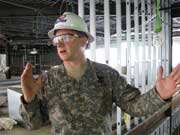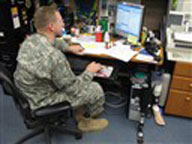|
Army's New Amputee Care CenterConstruction Effort Led by
|
|
"I’m trying on a new foot today," he said. "I like it. But any time you get a new foot, you’ve got to get used to it."
As an armored cavalry troop commander, Rozelle lost his right foot to an anti-tank mine in Iraq in 2003.
Since then, he has been cutting new paths for amputees in the Army. Rozelle is an expert skier, a tri-athlete, and one of the first Iraq war amputees to be deemed fit to return to active duty. Only a little more than a year after losing his foot, Rozelle stepped back in front of an armored cavalry formation as commander and led his troops back to the same battlefield that claimed his foot, almost cost him his Army career, and nearly took his life.
And, as fate would have it, Rozelle later returned to the very medical center that gave him back his foot, his Army career and, for the most part, his life as he enjoyed it before his injury.
Now, the two-time Iraq-war veteran is walking another path that takes him to the forefront of amputee care.
This path leads up and around a chain-linked fence to the front of a construction site -- his construction site.
As deputy to the program manager for amputee care at Walter Reed, Rozelle is in charge of construction of the new Amputee Care Center. When finished, its only equal will be the likes of the Center for the Intrepid -- a $50 million, 65,000-square-foot, state-of-the-art physical rehabilitation center recently opened on Fort Sam Houston, Texas.
This building will be smaller, about 30,000 square feet, but will boast many of the same amenities as the Center for the Intrepid. These include upper- and lower-body-specific training rooms, prosthetic adjustments, an indoor running track, a climbing and rappelling wall, and other exercise facilities aimed at getting patients to the "highest level of recovery and rehabilitation," Rozelle said.
More than just amputees will benefit from the facility, he said. Those suffering from traumatic brain injuries and others with severe injuries will also undergo rehabilitation there.
"It gives them hope"
Two sides of the building will be built with glass walls, allowing sunlight to penetrate throughout the upper indoor track area and down into the lower-level exercise rooms.
"It gives them hope as they are working out. They can look up and out and see the sunlight and think, 'You know, I’m on my way to being back outside,'" Rozelle said. "If they’re up on the track running, they will see people on the road running right next to them. That will give them hope to take that running outside."
When finished, the center will offer "the world’s best equipment and the world’s best therapists and the world’s best therapy," he said.
"These guys and girls are going back to active duty, and on to world-class athlete sports programs, and off to college. We get them back to where they deserve to be, and that’s at the highest level of physical training and ability," Rozelle said.
Rozelle was handpicked for the job because of his passion and commitment to amputee care, he said. "Who better to help guide the engineers and the builders on this project than an amputee who would use this facility?" Rozelle said.
Not here just to shake hands
"I think some people initially thought that I was here just to be to be kind of a feel-good guy on staff and walk around and shake hands, but I’ve been working really hard since I got here to get this building up and get the program straight inside the building. I like to think that I’ve been integral in a lot of different things, but obviously my blood and sweat goes into this project here," he said.
Rozelle’s job is to build the center, help develop policy and programs for the center, and to act as a mentor for injured soldiers.
He reported to work at the center in August 2005, but the Base Realignment and Closure process delayed the project’s start. After a handful of reviews by Army lawyers and Congress, eight months later the project was under way.
"Once we got started, we’ve been rolling. And we’ve not slowed down a bit," Rozelle said.
In the past six months, builders have gone from clearing the ground to "vertical" construction -- the placement of water pipes, air ducts, water, etc. Rozelle said he hopes to open the doors for business by October.
"Any day that this facility is not open is a day that we don’t have the best care for our veterans," he said. "It’s going to be a world class facility." Rozelle said that the Army has come a long way in breaking the previous models on how it treats and rehabilitates amputees. Care plans used to focus on getting the patient to the level of using crutches or a wheelchair and then turning them over to the Department of Veterans Affairs for the remaining rehabilitation. Patient feedback at the center has shown troops prefer to rehabilitate with the same doctors and therapy teams that begin their care.
Trail Blazer
Also before, there was very little discussion about the service member’s option of returning to duty after an amputation. Rozelle said officials first tried to push him into that model.
"The VA came to my room and gave me my separation paperwork. I kept saying, 'What’s this separation thing? Just because I am an amputee? You guys are telling me about all of these prosthetic legs and stuff. I can continue to serve,'" Rozelle said. "So, I was one of the first to break the mold."
In all, 63 amputees have returned to active duty across the services, he said.
Wouldn't call his service "difficult"
Rozelle admitted he had to make some accommodations to serve as a commander in Iraq, but wouldn’t say that his service was "difficult."
"It depends on how you define difficulty. I just had to plan things a little better. I had to have a back-up foot in my backpack. I had to always carry back-up parts," Rozelle said. "You have mechanical failures that you wouldn’t normally worry about with your body."
Rozelle is now trying a new prosthesis. A recent surgery made more prosthetic feet available to him.
|
"It’s pretty amazing. I can actually bend my knee all the way back," he said.
Now, Rozelle has to change feet to match his activity. He swims with no prosthetic, changes to a high-energy foot for cycling and a different foot for running.
Having finished his command-time requirement, Rozelle is now waiting for a seat at the Intermediate Level Education course, formerly the Command and General Staff Officer Course, at Fort Leavenworth, Kansas, while working on his building project. He hopes to finish the building before having to report to class.
If Rozelle doesn’t get a class date before finishing his project here, he is very matter-of-fact about the next path he expects to take next.
"As soon as this is done, I’ll go back to the Cav, … back to Iraq … and keep fighting," he said.
Update 2011: And that's just what he did. After completing this assignment, Major Rozelle returned to combat duty once again, serving a total of three deployments in Iraq, two of them after his injury.
In 2011, he became the commanding officer of the Army ROTC program at the University of Colorado Boulder, where he trains new Army officers. What better role model could they have?
Related:
Audio Report: Army Path Takes Amputee Soldier to Forefront of Amputee Care
Special Report: Defense Leaders Make Wounded Warrior Care Top Priority
Walter Reed National Military Medical Center Amputee Care

Return to top of Amputee Care Center.
Read more about Major Rozelle.
Return to Wounded Warriors.






New! Comments
Join our conversation! Leave me a comment about this page in the box below. If your comment is about another page on this site, please leave your comment on that page, because I have no ability to move it to the correct page. Thanks!